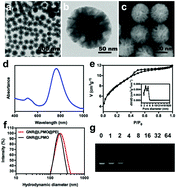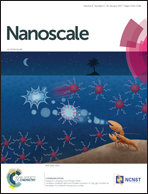Gold nanorod embedded large-pore mesoporous organosilica nanospheres for gene and photothermal cooperative therapy of triple negative breast cancer†
Abstract
To date, clinicians still lack an effective strategy to treat triple negative breast cancer (TNBC). In this work, we design for the first time a gold nanorod embedded large-pore mesoporous organosilica (GNR@LPMO) nanoplatform for gene and photothermal cooperative therapy of TNBC. The synthesized GNR@LPMOs possess a uniform size (175 nm), high surface area (631 m2 g−1), large pore size, excellent photothermal efficiency, and good biocompatibility. Thanks to the large-pore mesoporous organosilica layer, the GNR@LPMO nanoplatforms display much higher loading capacity of siRNA compared with traditional liposome and bare gold nanorods. Thus, functional siRNA can be efficiently delivered into TNBC cells by GNR@LPMOs, causing much higher cell apoptosis through knocking down the PLK1 proteins. By combining the effective gene delivery and photothermal abilities, the GNR@LPMO nanoplatforms are further used for gene and photothermal cooperative therapy of TNBC, which induce a 15 fold higher mice tumor inhibition rate than sole therapy modality, indicating the potential clinical use of this novel nanoplatform in treating TNBC.


 Please wait while we load your content...
Please wait while we load your content...